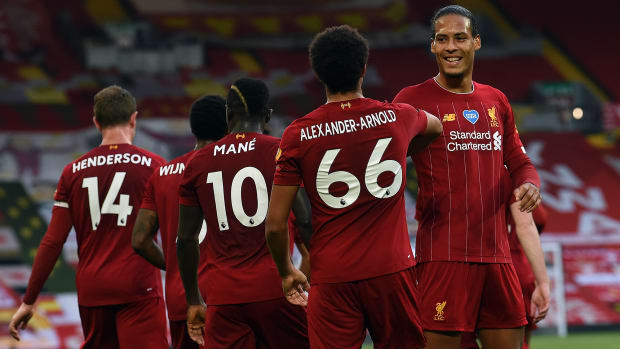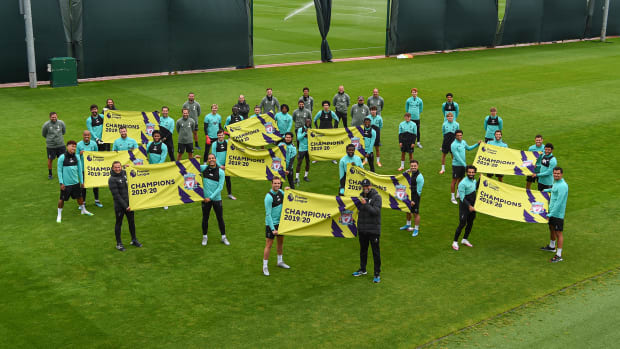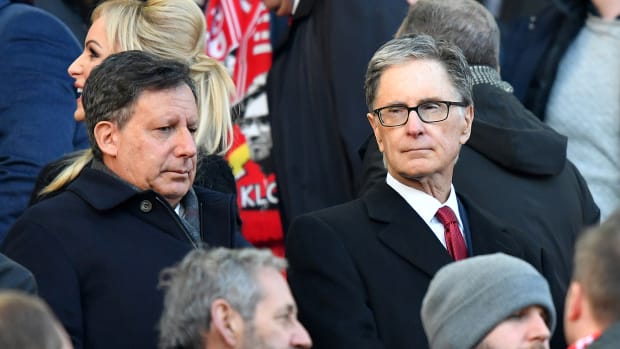New on Sports Illustrated: Why it Took Liverpool So Long to Return to the Top of the League
A 30-year drought for a club like Liverpool seemed unimaginable. Why it happened, how it was ended and the challenge to hold onto the Premier League's bragging rights.
The feeling last season was that Liverpool had made an incredible, exhausting effort and that, having given so much–a points total that had only previously been exceeded once before–and still fallen short that it would stumble this season. Manchester City looked imperious, and rebels tend only to get one chance. But Liverpool maintained its level–perhaps even improved–and it was Man City who cracked, undone by the failure to replace Vincent Kompany.
And so a
drought lasting three decades came to an end at Stamford Bridge on Thursday, as City lost to Chelsea, triumph confirmed in the strangest of circumstances. Liverpool’s players celebrated, in an isolated way in a hotel, while Merseyside was convulsed by a great release of emotion.On the one hand 30 years is an almost unimaginably long time for a club of Liverpool’s stature to go without winning the league, particularly given the position of strength it had in the late 1980s. That was just as the elite were plotting the creation of the Champions League, which would begin the process of further enriching the rich that has led football into its present, deeply unbalanced condition. On the other, some of the lachrymose gushing about the supposed hurt Liverpool fans have suffered–as it relates to sporting success–in that time has sounded preposterously entitled: they have, after all, seen their club win 16 trophies over those three decades, including two Champions League titles.

Perhaps some would argue that end of the drought justifies the mass celebratory gatherings. Liverpool fans certainly aren’t the only people to have breached government regulations on mass-gatherings and social distancing in recent weeks: there were street parties to mark the 75th anniversary of VE Day and marches in support of the Black Lives Matter movement, while recent days, as temperatures soared, saw beaches and parks overwhelmed. There has been a roiling sense of suppressed energy, the frustrations of lockdown exacerbated by the manifest failings of an obviously incompetent government, spilling over into numerous significant disturbances.
But the disorder on Merseyside, which saw fireworks fired from within a crowd, igniting the Liver Building, is precisely the sort of incident the mayor of Liverpool Joe Anderson was attacked for anticipating. There is a tendency to demonize football and its followers, one that seems to date from the 70s, but the reaction against that, which often seeks to absolve fans from any responsibility, is just as misguided. Jurgen Klopp had begged fans not to gather in large numbers, and the club and council have both condemned the incidents, which cannot but add an element of sourness to what should have been a week of celebration.
Still, the reasons for the drought are worth investigating. To an extent, it’s a feature of English football, which has never been dominated by a tiny elite in quite the way most other nations have. Liverpool itself, in the late 70s and 80s, was the first club to extend a sense of superiority over a decade. There have always been an array of challengers waiting to step up.

But there were also specific reasons why Liverpool faltered. There is a moment in Pete Davies’s book on the 1990 World Cup, All Played Out, in which he challenges England manager Bobby Robson on his reluctance to move away from a 4-4-2 formation. Robson, clearly sick of constant questioning about his supposedly old-fashioned tactics, responds snappishly, pointing out that Liverpool plays a 4-4-2 and nobody thinks it's finished. And yet it wouldn’t win the league for another 30 years.
Tactics are only part of it. Liverpool was a master of playing out from the back, but it did so with the safety net of the backpass. Once the law was changed and the option of going back to the keeper was removed in 1992, it struggled to adapt. But the game was changing in other ways, too. The coming of the Premiership changed the economics of the sport. Manchester United seized the new opportunities, Liverpool didn’t. Perhaps that’s a natural part of the ebb and flow of development as the dominant entity becomes complacent and is reluctant to adapt the processes that led it to preeminence.
But at the same time, the Hillsborough disaster had led to a circling of the wagons at Anfield and that perhaps made the club more resistant to change. Hillsborough was also responsible for the shocking resignation of a shattered Kenny Dalglish in 1991, breaking a direct line of succession that went back, though Joe Fagan and Bob Paisley to Bill Shankly. Although Graeme Souness had played for Liverpool, by the time he succeeded Dalglish, he was far removed from the boot-room traditions.
What followed was decades of trying to catch United, in which Liverpool was hampered by Anfield’s size and the difficulty of expansion. The Moores family had owned the club since before the Second World War and must take great credit for the way they built it into such a power, but by the early part of this century it had become apparent that Liverpool lacked the financial clout to compete with United or Roman Abramovich’s Chelsea. In 2007, John Moores sold up to U.S. businessmen George Gillett and Tom Hicks, but they demonstrated little familiarity with football, Liverpool or British law. In 2010 they were prosecuted by a number of the club’s creditors, eventually being forced to sell to John Henry’s Fenway Sports Group.

When FSG arrived, Liverpool was, unthinkably, in the bottom three of the Premier League–not that anybody expected it to remain there, even if it was £351 million in debt. The squad needed a serious overall. There came a spate of misguided signings: Andy Carroll was a failed gamble at £35 million, but worse were the three players bought purely because of their chance creation, an early and overly simplistic use of data: Charlie Adam, Stewart Downing and Jordan Henderson. Adam and Downing were soon exposed as not being good enough, and Liverpool tried to sell Henderson as well, only for him stubbornly to refuse to leave. He may have been bought for the wrong reasons but has developed into one of the club’s greatest captains. Luck comes into it, too.
Brendan Rodgers was almost an inspired appointment as manager, but what was perhaps most telling about his arrival was that it came after the dismissal of Dalglish, even though he had just won the League Cup in his second stint helming the club. FSG was prepared to be ruthless, too (although it might have been rather more ruthless over the Luis Suarez racism affair). It was ruthless as well in replacing Rodgers with Klopp, an appointment that brought to the club somebody who almost immediately seemed in tune with the city.
The age of the manager-messiah had seemed to be past. British football was blighted for years by the fact that in the late 60s and early 70s, as its television age began, the landscape was studded with charismatic leaders: Matt Busby, Jock Stein, Brian Clough, Don Revie and, of course, Shankly. The role of directors came to seem one primarily of identifying the next messiah, which in turn meant structural, technocratic issues tended to be overlooked. More recently, there has been a shift in the other direction, but Klopp is a throwback, somebody able to inspire not only his players but the crowd and the community. Occasionally, everything fuses into an unstoppable force, as Barcelona discovered at Anfield last season.
But Klopp is backed up by vast backroom staff, a team of analysts, conditioning coaches and nutritionists whose work is extremely difficult to assess from the outside, other than to note that Liverpool scores a lot of late goals and that its recent recruitment has been notably good. Liverpool presses ferociously hard, but it is also focused in its pressing: the players are fit, motivated and well-organized.

Although the notion of Liverpool as plucky and impoverished outsiders is hard to sustain–it has benefited as much as any big club from the unequal distribution of Champions League and Premier League revenues; however remarkable the achievement, if teams are regularly getting over 95 points, the system is broken–it has spent far, far less than City, or indeed Manchester United. The two big signings, Alisson and Virgil van Dijk, were both targeted and were funded largely by the sale of Philippe Coutinho (it’s a sobering glimpse of unintended consequences that Liverpool probably wouldn’t have won the league if Paris Saint-Germain hadn’t bought Neymar). But there have also been remarkable bargain signings, perhaps most notably Andy Robertson, picked up from relegated Hull City for £8 million.
How hard Man City hits back may depend on the outcome of its Champions League ban appeal in the Court of Arbitration for Sport. Manchester United and Chelsea are both building. There will be challenges next season. But perhaps the greatest challenge for Liverpool is internal.
In the glory days, Liverpool was a master at constant evolution. Success can be entropic; why, after all, would you choose to change something that is working? How can, for instance, Takumi Minamino, who was signed in January, be integrated into a front three that plays so well together? When Liverpool didn’t sign a senior outfield player last summer, it didn’t seem to matter because the squad was so generally young. Still, Henderson is the only one of a putative first XI to have hit 30. But the front three of Mohamed Salah, Roberto Firmino and Sadio Mane are all 28. Change will have to begin sooner rather than later, and managing transition can be extremely difficult.
Given how well-run Liverpool has been for the past decade, though, there’s every reason for optimism on Merseyside. And for now, it can spend the final games of the season basking in a long-awaited success, collecting whatever records it can.
Comments
Post a Comment